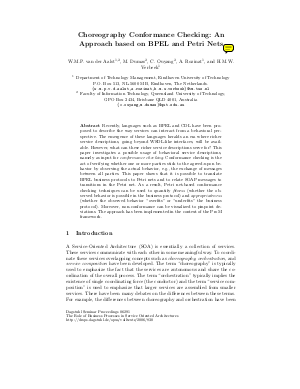Choreography Conformance Checking: An Approach based on BPEL and Petri Nets
Authors Wil van der Aalst, Marlon Dumas, C. Ouyang, Anne Rozinat, H. M. W. Verbeek
-
Part of:
Volume:
Dagstuhl Seminar Proceedings, Volume 6291
Part of: Series: Dagstuhl Seminar Proceedings (DagSemProc) - License:
 Creative Commons Attribution 4.0 International license
Creative Commons Attribution 4.0 International license
- Publication Date: 2006-11-27
File

PDF
DagSemProc.06291.9.pdf
- Filesize: 0.59 MB
- 71 pages
Document Identifiers
Subject Classification
Keywords
- Process mining
- SOAP messages
- BPEL
- Petri nets
Metrics
- Access Statistics
-
Total Accesses (updated on a weekly basis)
0Document
0Metadata
Abstract
Recently, languages such as BPEL and WS-CDL have been proposed to describe interactions between services and their behavioral dependencies. The emergence of these languages heralds an era where richer service descriptions, going beyond WSDL-like interfaces, will be available. However, what can these richer service descriptions serve for? This talk discussed the use of event logs of web services and behavioral service descriptions as input for process mining and conformance checking. Conformance checking is the act of verifying whether or not one or more parties stick to an agreed-upon behavior, by observing their actual behavior as recorded in message logs. This talk shows that it is possible to translate BPEL business abstract processes to Petri nets and to relate SOAP messages to transitions in the Petri net. The approach has been implemented in the ProM framework.
Cite As Get BibTex
Wil van der Aalst, Marlon Dumas, C. Ouyang, Anne Rozinat, and H. M. W. Verbeek. Choreography Conformance Checking: An Approach based on BPEL and Petri Nets. In The Role of Business Processes in Service Oriented Architectures. Dagstuhl Seminar Proceedings, Volume 6291, pp. 1-71, Schloss Dagstuhl – Leibniz-Zentrum für Informatik (2006)
https://doi.org/10.4230/DagSemProc.06291.9
BibTex
@InProceedings{vanderaalst_et_al:DagSemProc.06291.9,
author = {van der Aalst, Wil and Dumas, Marlon and Ouyang, C. and Rozinat, Anne and Verbeek, H. M. W.},
title = {{Choreography Conformance Checking: An Approach based on BPEL and Petri Nets}},
booktitle = {The Role of Business Processes in Service Oriented Architectures},
pages = {1--71},
series = {Dagstuhl Seminar Proceedings (DagSemProc)},
ISSN = {1862-4405},
year = {2006},
volume = {6291},
editor = {Frank Leymann and Wolfgang Reisig and Satish R. Thatte and Wil van der Aalst},
publisher = {Schloss Dagstuhl -- Leibniz-Zentrum f{\"u}r Informatik},
address = {Dagstuhl, Germany},
URL = {https://drops.dagstuhl.de/entities/document/10.4230/DagSemProc.06291.9},
URN = {urn:nbn:de:0030-drops-8307},
doi = {10.4230/DagSemProc.06291.9},
annote = {Keywords: Process mining, SOAP messages, BPEL, Petri nets}
}
